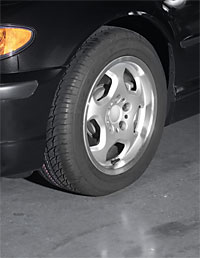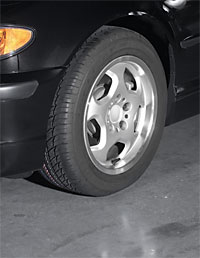Your Tires ?
#1
[align=center] Your Tires Are Talking
Your Tires Are Talking 

See your tires for what they really are, good or bad [:@].
good or bad [:@].
[/b]
Wear at the edges. Underinflation [X(]is usually the cause of this type of wear, although wear at the outer edges can also be caused by aggressive driving. Underinflation causes too much force to be placed on the edges and not enough on the center.

Wear on one side. With this type of wear, the inside of the tread shows more wear than the outside, or vice versa. Poor alignment, worn ball joints, or other worn or bent suspension parts might be the cause. Bring your car in for a proper alignment and an inspection of your suspension components.

Feathering. Feathering means that each tread rib looks worn in one direction, such that one side is rounded while the other side is pointed, looking almost smeared outward. Sustained high-speed driving can sometimes cause feathering, although consistent feathering most often reveals an improper toe-in alignment setting. Again, take your car in and have the alignment checked by a specialist.
More Autos Stories
Bonus
[:-][/align][*][align=center]Oil Changing Tips[/align][*][align=center]Oil Change Tips[/align][*][align=center]Is Your Speedometer Off?[/align][align=center]
Cupping. Rounded, scalloped dips near one edge of the tread indicate severely worn suspension components. Go to your mechanic and have the suspension inspected immediately.

Flat-spotting. Flat-spotting, severe wear of the whole tread contact patch in one place on the tire, results from panic-braking (skidding) with the wheels locked up, usually on older cars without ABS. The flat spot will often introduce an imbalance that can be felt in the steering wheel. The imbalance from the flat spot makes the tires unsafe-replacement is the only safe solution, although if there is plenty of tread left on the tires, a professional tire shop might be able to shave the tread down.

Bald spots. Smooth spots on the tread, or areas between the edge and the center of the tread that are more worn than others, might indicate a wheel that's way out of balance. Front wheels out of balance are usually easy to feel, but sometimes rear wheels are overlooked. Have your wheels balanced at any service station or tire store.

[b][color=#9933
 Your Tires Are Talking
Your Tires Are Talking 

See your tires for what they really are,
 good or bad [:@].
good or bad [:@].[/b]
Wear at the edges. Underinflation [X(]is usually the cause of this type of wear, although wear at the outer edges can also be caused by aggressive driving. Underinflation causes too much force to be placed on the edges and not enough on the center.

Wear on one side. With this type of wear, the inside of the tread shows more wear than the outside, or vice versa. Poor alignment, worn ball joints, or other worn or bent suspension parts might be the cause. Bring your car in for a proper alignment and an inspection of your suspension components.

Feathering. Feathering means that each tread rib looks worn in one direction, such that one side is rounded while the other side is pointed, looking almost smeared outward. Sustained high-speed driving can sometimes cause feathering, although consistent feathering most often reveals an improper toe-in alignment setting. Again, take your car in and have the alignment checked by a specialist.
More Autos Stories
Bonus
[:-][/align][*][align=center]Oil Changing Tips[/align][*][align=center]Oil Change Tips[/align][*][align=center]Is Your Speedometer Off?[/align][align=center]

Cupping. Rounded, scalloped dips near one edge of the tread indicate severely worn suspension components. Go to your mechanic and have the suspension inspected immediately.

Flat-spotting. Flat-spotting, severe wear of the whole tread contact patch in one place on the tire, results from panic-braking (skidding) with the wheels locked up, usually on older cars without ABS. The flat spot will often introduce an imbalance that can be felt in the steering wheel. The imbalance from the flat spot makes the tires unsafe-replacement is the only safe solution, although if there is plenty of tread left on the tires, a professional tire shop might be able to shave the tread down.

Bald spots. Smooth spots on the tread, or areas between the edge and the center of the tread that are more worn than others, might indicate a wheel that's way out of balance. Front wheels out of balance are usually easy to feel, but sometimes rear wheels are overlooked. Have your wheels balanced at any service station or tire store.

[b][color=#9933
#2
Yeah, you could say under inflated.  My last drag race of the year I had the car down to 12 psi on the front to see if I could get some grip and it helped a bit. Problem is I ripped all the rubber off the inside of tires... Just go cords there now.
My last drag race of the year I had the car down to 12 psi on the front to see if I could get some grip and it helped a bit. Problem is I ripped all the rubber off the inside of tires... Just go cords there now.
 My last drag race of the year I had the car down to 12 psi on the front to see if I could get some grip and it helped a bit. Problem is I ripped all the rubber off the inside of tires... Just go cords there now.
My last drag race of the year I had the car down to 12 psi on the front to see if I could get some grip and it helped a bit. Problem is I ripped all the rubber off the inside of tires... Just go cords there now.
#3
You missed one - Overinflation. The Michelins Pilots I have on the Intimidator SS right now, wore out in the centers, I started running them at 30 psi, LESS than factory recommendation. I ended up at 28 psi, and wore them oput totally, I didn't get only about 25-30,000 miles on them. Not sure exactly, cause I didn't document the milage when I changed wheels. I don't think I've ever wore out a set of tires from the center, but being the stock size tire, the only thing it could be is overinflation, cause they wore even, all 4 tires.
This leads me to my next new thread, which tires to buy next?
This leads me to my next new thread, which tires to buy next?
#4
Hi Wayne, -RocknSS04-, for your correction/addition about Overinflated Tires. Below infor is from TireRack.com
Good Information...Thanks for posting.
Air Pressure – Correct, Underinflated and Overinflated[/align]
Advantages of Correct Tire Inflation
Maintaining correct tire inflation pressure helps optimize tire performance and fuel economy. Correct tire inflation pressure allows drivers to experience tire comfort, durability and performance designed to match the needs of their vehicles. Tire deflection (the tread and sidewall flexing where the tread comes into contact with the road) will remain as originally designed and excessive sidewall flexing and tread squirm will be avoided. Heat buildup will be managed and rolling resistance will be appropriate. Proper tire inflation pressure also stabilizes the tire's structure, blending the tire's responsiveness, traction and handling.
Can you easily identify which tire is 30% underinflated? Here is what they would look like in the morning parked in your garage.
(Roll your mouse across the pictures to find out if you were right.)


Tough to tell; isn't it? Tire pressure must be checked with a quality air gauge as the inflation pressure cannot be accurately estimated through visual inspection.
Disadvantages of Underinflation
An underinflated tire can't maintain its shape and becomes flatter than intended while in contact with the road. If a vehicle's tires are underinflated by only 6 psi it could weaken the tire's internal structure and eventually lead to tire failure. Lower inflation pressures will allow more deflection as the tire rolls. This will build up more internal heat, increase rolling resistance (causing a reduction in fuel economy of up to 5%) and reduce the tire's tread life by as much as 25% while increasing the probability of irregular treadwear. Drivers would also find a noteworthy loss of steering precision and cornering stability. While 6 psi doesn't seem excessively low, it typically represents about 20% of a passenger car tire's recommended pressure.
Disadvantages of Overinflation
An overinflated tire is stiff and unyielding and the size of its footprint in contact with the road is reduced. If a vehicle's tires are overinflated by 6 psi, they could be damaged more easily when encountering potholes or debris in the road, as well as experience irregular tread wear. Higher inflated tires cannot isolate road irregularities as well causing the vehicle to ride harsher and transmit more noise into its interior. However, higher inflation pressures reduce rolling resistance slightly and typically provide a slight improvement in steering response and cornering stability. This is why participants who use street tires in autocrosses, track events and road races run higher than normal inflation pressures.
Most Popular Links
Air Pressure - Correct, Underinflated and Overinflated
Air Pressure vs. Dry Performance
Air Pressure vs. Wet Performance
[URL=http://www.tirerack.com/tires/tiretech/techpage.jsp?techid=73]Air Pressure, Temperature Fluctuations[/
Good Information...Thanks for posting.
Air Pressure – Correct, Underinflated and Overinflated[/align]
Advantages of Correct Tire Inflation
Maintaining correct tire inflation pressure helps optimize tire performance and fuel economy. Correct tire inflation pressure allows drivers to experience tire comfort, durability and performance designed to match the needs of their vehicles. Tire deflection (the tread and sidewall flexing where the tread comes into contact with the road) will remain as originally designed and excessive sidewall flexing and tread squirm will be avoided. Heat buildup will be managed and rolling resistance will be appropriate. Proper tire inflation pressure also stabilizes the tire's structure, blending the tire's responsiveness, traction and handling.
Can you easily identify which tire is 30% underinflated? Here is what they would look like in the morning parked in your garage.
(Roll your mouse across the pictures to find out if you were right.)


Tough to tell; isn't it? Tire pressure must be checked with a quality air gauge as the inflation pressure cannot be accurately estimated through visual inspection.
Disadvantages of Underinflation
An underinflated tire can't maintain its shape and becomes flatter than intended while in contact with the road. If a vehicle's tires are underinflated by only 6 psi it could weaken the tire's internal structure and eventually lead to tire failure. Lower inflation pressures will allow more deflection as the tire rolls. This will build up more internal heat, increase rolling resistance (causing a reduction in fuel economy of up to 5%) and reduce the tire's tread life by as much as 25% while increasing the probability of irregular treadwear. Drivers would also find a noteworthy loss of steering precision and cornering stability. While 6 psi doesn't seem excessively low, it typically represents about 20% of a passenger car tire's recommended pressure.
Disadvantages of Overinflation
An overinflated tire is stiff and unyielding and the size of its footprint in contact with the road is reduced. If a vehicle's tires are overinflated by 6 psi, they could be damaged more easily when encountering potholes or debris in the road, as well as experience irregular tread wear. Higher inflated tires cannot isolate road irregularities as well causing the vehicle to ride harsher and transmit more noise into its interior. However, higher inflation pressures reduce rolling resistance slightly and typically provide a slight improvement in steering response and cornering stability. This is why participants who use street tires in autocrosses, track events and road races run higher than normal inflation pressures.
Most Popular Links
Air Pressure - Correct, Underinflated and Overinflated
Air Pressure vs. Dry Performance
Air Pressure vs. Wet Performance
[URL=http://www.tirerack.com/tires/tiretech/techpage.jsp?techid=73]Air Pressure, Temperature Fluctuations[/
Thread
Thread Starter
Forum
Replies
Last Post
Space
Tires/Rims/Suspension
4
09-13-2013 10:34 AM















